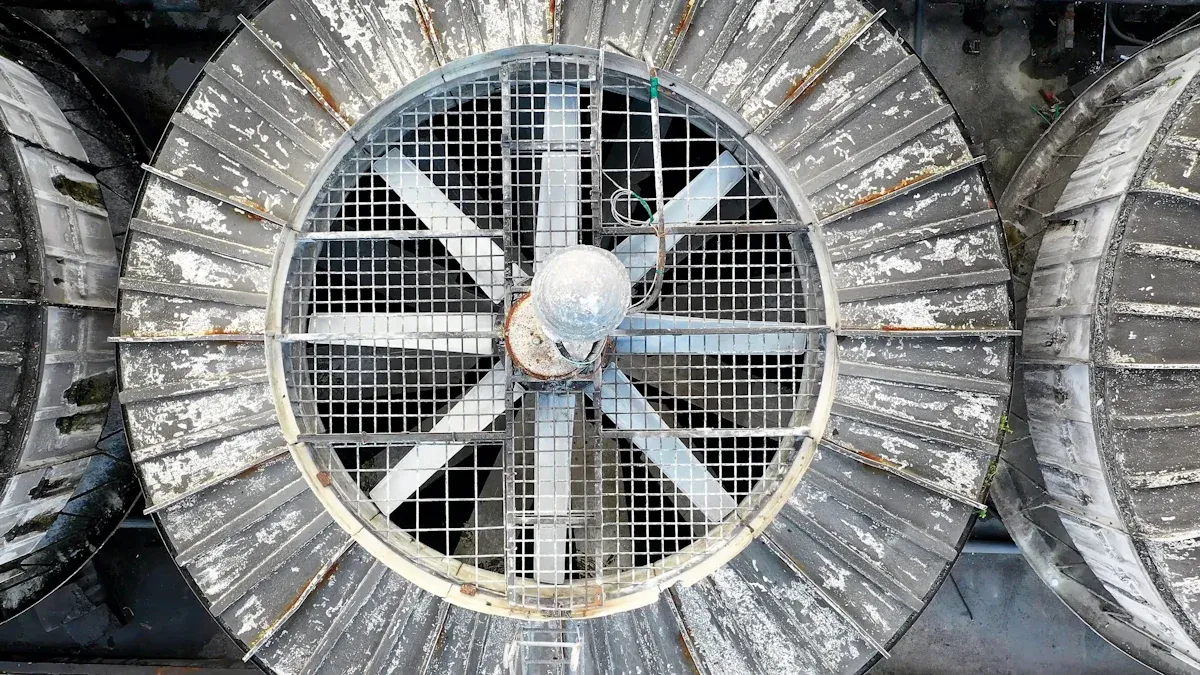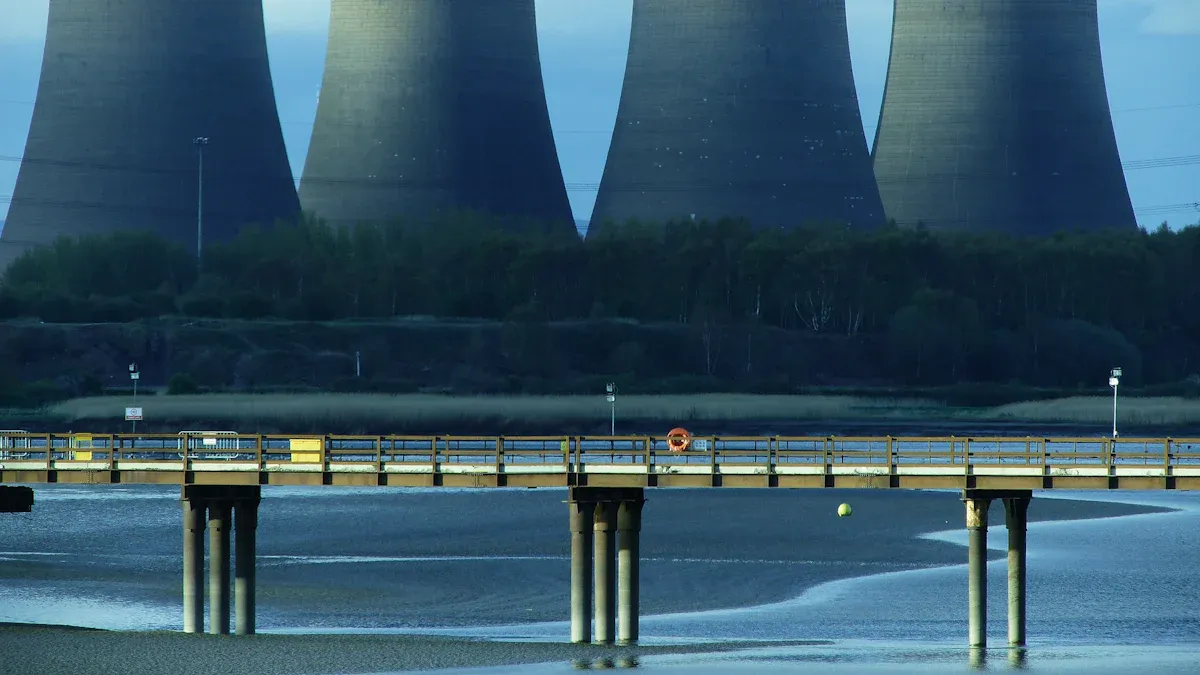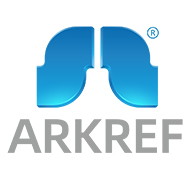What Are Chiller Units and How Do They Work

A chiller unit is a machine that cools liquids using refrigeration. It helps cool equipment, processes, or spaces efficiently. These machines are important for industries needing steady cooling systems. For example, HVAC systems use chillers to keep indoor spaces comfortable. Factories use them to cool machines during production work. Data centers depend on chillers to stop servers from overheating. Chiller units are useful in many different industries.
Key Takeaways
Chillers cool liquids with refrigeration and are used in HVAC, factories, and data centers.
The refrigeration cycle includes compression, condensation, expansion, and evaporation.
Taking care of parts like compressors and condensers saves energy.
Pick air-cooled or water-cooled chillers based on your cooling needs.
Chillers save energy and money while helping the environment.
What Is a Chiller Unit?

Definition and Purpose of a Chiller Unit
A chiller unit is a machine that cools liquids by removing heat. It uses a refrigeration process to make the liquid colder. This cold liquid helps cool equipment, spaces, or processes. These machines are used where keeping temperatures steady is very important. For example, HVAC systems use them to keep indoor spaces comfortable. They are also important in factories to stop machines from overheating.
The science behind a chiller unit works on three main ideas:
Principle | Description |
|---|---|
Boiling and Condensation | Liquids boil when heated and gases condense when cooled. |
Pressure and Boiling Point | Lower pressure makes liquids boil at lower temperatures. |
Heat Flow | Heat moves from warmer areas to cooler ones. |
These ideas help the chiller take heat from one place and release it somewhere else. This keeps things cool effectively.
Overview of Chilled Water Systems
Chilled water systems are a common way to use chiller units. These systems send chilled water through pipes to cool buildings, machines, or processes. The water takes heat from the area and goes back to the chiller to cool down again. This cycle repeats to keep the temperature steady.
You can find chilled water systems in big buildings, hospitals, and factories. They are great for cooling large spaces or equipment. These systems include a chiller, pipes, and pumps to move the water around.
One big benefit of chilled water systems is their flexibility. They can be used for many things, like air conditioning or cooling machines. They also save energy and cut costs by centralizing cooling.
Types of Chillers: Air-Cooled and Water-Cooled
There are two main types of chillers: air-cooled and water-cooled. Each type works best for certain uses.
Air-Cooled Chiller:
Air-cooled chillers use fans to release heat into the air. They are good for outdoor spaces with limited room. They need less upkeep since they don’t use extra water. But, they might not work as well in very hot places because air temperature affects them.Water-Cooled Chiller:
Water-cooled chillers use water to get rid of heat. They are usually placed indoors and connected to a cooling tower. These chillers are more efficient for big jobs. However, they need a steady water supply and regular care to avoid problems like scaling.
Choosing between air-cooled and water-cooled chillers depends on your needs. Things like space, weather, and cooling needs are important to consider.
How Chiller Units Work
The Refrigeration Cycle: Compression, Condensation, Expansion, and Evaporation
The refrigeration cycle is how a chiller works. It has four steps: compression, condensation, expansion, and evaporation. Each step helps remove heat and cool the liquid. Here's how it happens:
Step | Description | Example |
|---|---|---|
Compression | The compressor makes the refrigerant gas hot and high-pressure. | A scroll compressor in a 50-ton chiller cools 600,000 BTUs per hour. |
Condensation | The refrigerant gas cools and turns into liquid, losing heat. | A 100-ton chiller releases heat to air at 85°F for condensation. |
Expansion | The expansion valve lowers the refrigerant's pressure, making it cold. | The refrigerant cools to 35°F after passing through the valve. |
Evaporation | The cold refrigerant absorbs heat from water, cooling it down. | Chilled water cools to 44°F before going to air units. |
In simple terms, the compressor starts by pressurizing the refrigerant. This gas moves to the condenser, where it cools and becomes liquid. The expansion valve lowers its pressure, making it cold. Finally, the refrigerant absorbs heat from water in the evaporator, finishing the cycle.
Heat Transfer Process in Chillers
Chillers cool liquids by absorbing heat. The refrigerant inside takes heat from the chilled water. This heat is then released into the air or water, depending on the chiller type.
For example, air-cooled chillers use fans to blow air over coils to remove heat. Water-cooled chillers transfer heat to water, which is cooled in a tower. This process keeps the chilled water at the right temperature.
The chiller's design and conditions affect how well it works. Cleaning coils or ensuring good water flow can improve performance.
Role of Chilled Water in Cooling Systems
Chilled water carries heat away from spaces or machines. It flows through pipes, taking heat from the area. Then, it returns to the chiller to cool down again.
This method is great for big systems like hospitals or factories. Chilled water systems save energy by centralizing cooling.
For example, in HVAC systems, chilled water cools air in air handling units. This air is then sent through the building, keeping it comfortable and efficient.
Chilled water allows precise temperature control. It’s perfect for places needing steady cooling, like data centers or medical tools.
Key Parts of a Chiller Unit
Compressor: Powering the Cooling Process
The compressor is like the engine of the chiller. It pushes the refrigerant by increasing its pressure. This makes the refrigerant hotter and ready to release heat in the condenser. Compressors come in different types, like Copeland Hermetic or scroll compressors. These are known for being reliable and energy-saving.
A good compressor keeps the chiller working well. For example, in absorption systems, the compressor helps the cooling process stay efficient. Installing it correctly and checking it often is important for it to work its best.
Part | Feature |
|---|---|
Compressors | Types include Copeland Hermetic and Scroll compressors. |
Energy Saving | |
Easy Repairs | Cabinets can be removed for quick access to parts. |
Condenser: Releasing Heat
The condenser is where the refrigerant lets go of heat. This changes the refrigerant from a hot gas to a liquid. Air-cooled chillers use fans to blow air over the condenser coils to cool them. Water-cooled chillers use water in cooling towers to do the same job.
How well the condenser works affects how much heat the evaporator can absorb. Cleaning the condenser coils often helps it work better and improves the chiller's performance.
Important Part | Details |
|---|---|
Setup Instructions | |
Help Available | Support offered for setup and use. |
Expansion Valve: Managing Refrigerant Flow
The expansion valve controls how much refrigerant enters the evaporator. It lowers the refrigerant's pressure, making it very cold. This cold refrigerant then absorbs heat from the chilled water.
In absorption systems, the expansion valve helps keep the temperature steady. A well-set valve saves energy and makes the chiller more effective.
Help Type | Information |
|---|---|
Expert Team | Offers advice for smooth operation. |
By learning about these parts, you can see how they work together to cool things. Taking care of these parts keeps the chiller running well and saves energy.
Evaporator: Taking heat away from the liquid.
The evaporator is very important in a chiller. It cools the liquid by taking away its heat. Inside, the refrigerant moves through coils or tubes. As it flows, it absorbs heat from the liquid, like chilled water, around the coils. This process makes the liquid colder for cooling systems.
Think of the evaporator as the main part for cooling. For example, in chilled water systems, it cools water before it moves through buildings or machines. This chilled water then takes heat from spaces or equipment, keeping them cool. Without the evaporator, the chiller couldn’t keep things at the right temperature.
To keep it working well, regular care is needed. Cleaning the coils and removing blockages helps it perform better. A clean evaporator keeps the chilled water at the right temperature, ensuring steady cooling.
Refrigerant: The key to moving heat.
The refrigerant is what makes a chiller work. It carries heat away from the liquid being cooled. During the cycle, it changes between liquid and gas. This lets it absorb and release heat easily.
In the evaporator, the refrigerant takes heat from chilled water and becomes gas. Then, it goes to the condenser, where it releases heat and turns back into liquid. This cycle repeats to keep the chilled water cold.
Picking the right refrigerant is important for saving energy and helping the environment. New refrigerants are made to cool well without harming nature. Knowing how refrigerants work shows how they keep chillers running and water cool.
Uses of Chiller Units
Chiller units are important for many industries. They provide reliable cooling for different needs. Let’s look at some common uses.
HVAC systems in buildings
Chillers are key in HVAC systems to keep spaces comfortable. In big buildings like offices or malls, they cool large areas. Chilled water moves through pipes to cool air. This air is then sent around the building to keep it cool.
In homes, smaller HVAC systems often use absorption chillers. These chillers are quiet and save energy. By using chilled water, HVAC systems help keep both small and large spaces comfortable.
Factories and production processes
Factories use chillers to control temperatures during production. For example, in plastic molding, chilled water cools molds fast. This helps products keep their shape and quality. Without chillers, production could slow or make bad items.
Chemical factories also need chillers. Many chemical reactions create heat that can cause problems. Chillers help keep temperatures steady, making the process safer and better. Using chillers in factories saves energy and boosts productivity.
Cooling data centers
Data centers have servers that get very hot. Without cooling, these servers could break. Chillers help by moving chilled water to cool server rooms. This keeps equipment safe and working well.
Absorption chillers are great for data centers. They save energy and work well for places running all day. Chillers protect equipment and keep operations running smoothly.
Medical equipment like MRI machines.
Chillers are very important for medical tools like MRI machines. These machines create a lot of heat when they work. If they get too hot, they might stop working. Chilled water systems keep MRI machines cool and safe to use.
Here’s how it works: chilled water takes heat from the MRI machine. The water then goes back to the chiller to cool down again. This process repeats to keep the machine working well. Hospitals often use absorption chillers because they save energy and are dependable. They provide the exact cooling needed for delicate medical tools.
Using chillers in hospitals has many advantages. They stop expensive machines from breaking due to overheating. They also make sure patients are safe by keeping machines ready for use. Regular care of these systems is important to avoid problems in healthcare.
Food and beverage processing.
Keeping the right temperature is very important in food work. Chillers are used to cool liquids, store ingredients, and help production. For example, breweries use chilled water to cool beer while it ferments. This helps the beer taste good and stay high quality.
Absorption chillers are common in this field. They use heat instead of electricity, saving money and helping the planet. Dairy plants use them to keep milk and other foods fresh. Chocolate makers also use them to keep chocolate smooth during production.
Chillers are useful for many food jobs. They stop bacteria from growing in places needing cool temperatures. Chilled water systems give steady cooling, which makes better products and less waste.
Benefits of Chiller Units
Energy efficiency and cost-effectiveness
Chiller units save energy by using it wisely. They centralize cooling, which lowers the energy needed to keep temperatures steady. For instance, chilled water systems cool large areas without wasting energy. This helps reduce electricity bills and keeps cooling reliable.
Modern chillers have smart features like variable-speed compressors. These adjust how much they work based on cooling needs. This avoids wasting energy and saves money. Taking care of parts like the evaporator and condenser also boosts efficiency. Clean parts help the system run better, cutting costs over time.
Environmental sustainability
Chillers help the environment by using eco-friendly refrigerants. Many now use low-GWP refrigerants, which lower pollution and save energy. These refrigerants are better for the planet and reduce cooling costs. Companies are making more of these to protect nature.
You can also pick chillers with natural refrigerants. These use less energy and create fewer emissions. Choosing these systems supports a healthier planet. Eco-friendly cooling helps both the environment and your budget.
Benefits of green chillers:
Lower energy costs.
Smaller carbon footprints.
Support for eco-friendly refrigerants.
Versatility across industries
Chiller units work well in many industries. In HVAC systems, they cool homes and buildings. Factories use them to control temperatures during production. For example, chilled water cools molds in plastic factories to ensure good products.
Data centers use chillers to stop servers from overheating. Hospitals rely on them to keep machines like MRI scanners cool. The food industry also benefits from chillers. Breweries, dairies, and chocolate makers use them to keep things at the right temperature.
This flexibility makes chillers useful for many jobs. Whether cooling small spaces or big factories, they provide reliable results.
Precision cooling for critical applications.
Precision cooling is crucial for places needing exact temperatures. It is used in healthcare, data centers, and factories. These areas need steady cooling to keep equipment working well and processes stable.
In data centers, servers make a lot of heat. Without cooling, they can overheat and stop working. Chilled water systems help by moving water to take away heat. This keeps servers cool and running properly.
Hospitals also need precision cooling for machines like MRI scanners. These machines must stay cool to work correctly. Chilled water systems are great because they provide steady cooling. This protects both the machines and patients.
Factories making delicate items also use precision cooling. For example, making semiconductors needs exact temperatures. Even small changes can ruin the products. Chillers keep the right conditions for good results.
Precision cooling systems, like chilled water systems, have many benefits. They work reliably, save energy, and protect expensive equipment. Using these systems ensures important tasks run smoothly and efficiently.
Tip: Take care of your chillers and cooling systems often. Clean parts and check performance to avoid problems and make them last longer.
Chiller units are key in cooling systems, keeping temperatures steady. They are used in healthcare, factories, and data centers. These systems help important machines and processes work properly.
Chillers have many benefits like saving money, better air quality, and being eco-friendly. For instance, chilled water systems need little care and last a long time. Industries like food and medicine rely on them for strict temperature control. This shows how useful they are for energy-saving cooling.
New technology, like AI and IoT, makes chillers even better. They now provide exact cooling for special needs. Whether cooling servers or keeping food safe, chillers solve cooling problems well.
Note: Buying a chiller unit gives good cooling, saves money, and helps the planet.
FAQ
What is the difference between air-cooled and water-cooled chillers?
Air-cooled chillers use fans to cool by releasing heat into the air. They work well outdoors. Water-cooled chillers use water and cooling towers to remove heat. These are better for big jobs and are more efficient. Pick one based on your space, cooling needs, and weather.
How do you maintain a chiller unit?
To keep a chiller working well, clean the condenser coils often. Check refrigerant levels and inspect parts like the compressor and evaporator. Hire professionals for regular servicing. This helps the chiller last longer and saves energy.
Can chiller units save energy?
Yes, modern chillers are built to save energy. They use smart features like variable-speed compressors and eco-friendly refrigerants. These lower energy use and cut costs. Keeping the chiller in good shape also boosts efficiency.
What industries benefit most from chiller units?
Chillers are helpful in many industries. HVAC systems, factories, data centers, hospitals, and food processing all use them. They keep equipment safe, improve product quality, and make processes run smoothly.
Are chillers environmentally friendly?
Yes, many chillers now use eco-friendly refrigerants that are better for the planet. Energy-saving designs also reduce pollution. Choosing these chillers helps the environment and lowers energy bills.
Tip: Pick a chiller that fits your cooling needs and eco goals for the best results.
See Also
A Comprehensive Guide To Water Chiller Units
Choosing The Right Industrial Water Chiller Units
Maximizing Performance Of Chillers And Compressors In ARKREF

